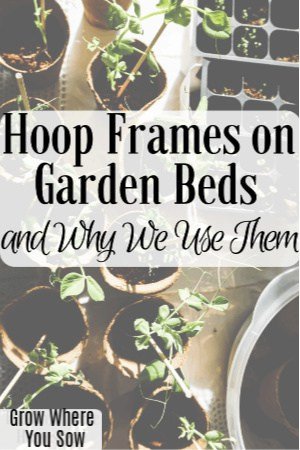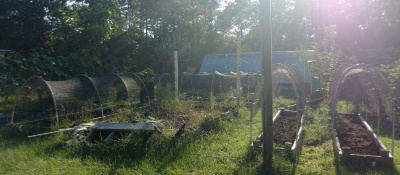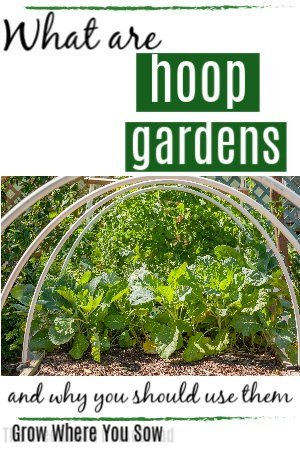Hoop frames on garden beds
Using hoop frames on our gardens is the only way we can grow crops in the summer. I live in West Central Florida so it gets pretty darn hot here. I’ve made my life a little bit easier by installing hoop garden frames for my raised beds!

Table of contents
Why we use garden hoop tunnel frames on our raised garden beds.
When my husband and I started gardening on our homestead it presented its challenges. I’m not going to tell you I have mastered gardening because I surely have not, but the hoop frames sure help!
Water
Being in the hot state of Florida, I have to water my gardens quite often. It seems that the moment I would water my beds, the sun would drink it up and my soil would be back to looking dried up all over again. Not to mention, we’re on a well, so every drop of water I use is a drop I’m not getting back.
When I finally decided to install my hoop frames on my beds it was getting a bit cooler, whatever that means in Florida. The hoop frames made all the difference for the summer season! Now, this summer was unusually rainy, even for Florida, but even on the hottest days, my soil stayed more saturated.
I put a black sunshade on my hoops, blocking 30-40% of the sun. While this won’t be ideal with all crops, such as corn, I found most crops it works great for (especially where I’m located). That shade prevents the water from immediately evaporating under the sun here. Money saved, resources saved, happy plants, and happy me was the result!
Soil
Speaking of soil, hoop frames will reduce the likelihood of your soils lifespan ending as soon. We often add mulches to our gardens to retain moisture, cut down on weeds, and expand the life of our soil. Hoop frames won’t cut down on weeds, but they help your soil last a little longer by preventing it from getting scorched by the sun around the clock.
I found, at the end of our spring/summer growing season, I was not as upset with my soil as I was last year. Yes, I still added compost and more soil to top off the beds, but the beds were in much better shape even before adding the rich humus. Win!
Growing Season
This might be the best, biggest, most wonderful reason to use hoop frames on your garden beds! If you’re an experienced gardener you might be thinking “Why are you trying to extend your growing season in Florida?”.
It’s true, here in the sunshine state we are able to garden almost year-round depending on where you’re located. Mostly, I was trying to extend my spring/summer season.
Last year, by the end of June/early July, all of our plants were ripped out of the ground. The sun was hot as hades and my plants hardly stood a chance. Not this summer! I had collards, arugula, and kale in the ground almost until August this year.
You see, the shade cloth cools your beds by not allowing the sun through at its full potential, providing a cooler environment for your greenery. Kale in late July in Florida? I’ll take it! With these hoop additions, I’ll be able to add to my list of “The 5 Easiest Vegetables to Grow“!
Versatile
A bonus point on hoop frames is that they’re somewhat versatile. My frames can be hoop shades, but I can also add “greenhouse” material to them if we have an odd winter, like last year, that’s cool and overcast. Just as the black shade cloth cools off the beds, your greenhouse tarp with heat the beds up.
Another aspect I’m really looking forward to as far as the hoop frames go is the easy ability to cover crops for hard freezes. Last year, I had a 12 x 4-foot bed of broccoli, about 16 heads. It was my first year growing broccoli and, being my favorite vegetable, I was so excited!
We had three hard freezes in a row and, even though I did cover them, when the sheet thawed out on top of the broccoli heads it was too much water. My broccoli turned to mush and I received zero harvests; I was so upset. This winter I’ll be able to cover my beds without having to lay the sheet/fabric directly on top of the plants. I could just even add the greenhouse tarp to the beds and call it a day!
BONUS REASON: Installing hoop frames with shade cloth on your garden beds with also deter pests!
How to Make the Hoop Frames
The hoop frames are quick and easy to install! You don’t need to spend hundreds of dollars on a kit or anything.
What you’ll need:
- PVC pipe (or some other flexible type of pole-shaped material) Two-Hole Conduit Straps
- Screws
- Screwdriver
- Scissors
- Zip Ties
- Shade Cloth
The most expensive part of this project will be the shade cloth, depending on how many garden beds you’re covering. I bought 84 feet, spent $102.39 (after tax/shipping!), and covered five 12×4-foot garden beds and two 12×2-foot garden beds.
The shade I linked above is the exact type I bought through Greenhouse Megastore and it’s sold per foot, which worked great for me!
Directions to assembling your hoop frames:
Screw your Two-Hole Conduit Straps to your raised beds. You should have one exactly opposite each other on each side of the bed.
Once you’ve screwed your conduit straps in, take your PVC and stick one end in one of the conduits, and bend the PVC to reach the other conduit on the opposite side of the bed. You have your hoop frame, now! I used 8 conduits on each of my beds (four on one side, four on the opposite) and four pieces of PVC.
Then unroll your shade cloth and drape it over your frames. Cut the clothe to the correct size and zip-tie it to the hoops.
BONUS TIP: Don’t zip-tye your cloth too tight. You want it snug, but not so tight that you can’t slide the zip-tyes. This will make it easier to move the shade cloth once harvest time rolls around. I just slide my cloth up the PVC pole and then slide it back down when I’m done. I NEVER fully remove my hoops!
That’s it, you’re done! This is how my raised bed gardens currently look with their hoop covers. Not only do hoop frames on your raised beds give you multiple benefits through the growing season, they also look nice!



I have been thinking about making hoop houses for my raised beds in SE Arizona. It also gets very hot here in the summer. I was wondering how you figured out how long to make your PVC pipe. I have 4′ wide beds.
Hi Rose! I love my hoops. My beds are also 4feet wide so one full-length PVC will work perfectly!
i was just thinking about do this in my garden! this next spring/summer season…its get hot here in Texas and for what i want to grow this idea will definitely help my plants.
We waited about 1.5 years to do it and I’m not sure why! Here in Florida, it is hot, hot, hot. My husband is from Austin so we’re familiar with the hot, dry Texas heat. I can’t imagine the obstacles there are while gardening there! Good luck with installing your hoops and let me know how it goes if you think about it. Thanks for stopping by!
This was a great read, I learned a few new things. Thanks for sharing on To Grandma’s House We Go!
Thank you. And thanks for hosting such a great hop, Chas!